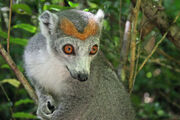No edit summary |
No edit summary |
||
| Line 1: | Line 1: | ||
| − | Cathemerality-Behavior in which an organism exhibits activity during the day or night |
+ | Cathemerality-Behavior in which an organism exhibits activity during the day or night where food is obtained or socializing with other animals occurs. This is seen in many mammals, mostly primates, but has been studied greatly in lemurs of Madagascar with five extinct species of'' ''lemurs of the genus ''eulemur''. The cornea size of this genus is in between those of nocturnal and diurnal strepsirrhines. Results show that cathemerality in'' eulemur'' is an ancient adaptation of lemur found in their last common ancestor. It has also been noted that cathermeral lemurs tend to have a relatively larger brain size than lemurs exhibiting diurnal behavor, but studies did not show much difference in the comparison to nocturnal species (MacLean, Barrickman, Johnson, & Wall, 2009). |
Kirk, E. C. (2006). Eye morphology in cathemeral lemurids and other mammals. ''Folia Primatologica'', ''77''(1-2), 27-49. |
Kirk, E. C. (2006). Eye morphology in cathemeral lemurids and other mammals. ''Folia Primatologica'', ''77''(1-2), 27-49. |
||
| + | |||
| + | <span style="line-height:normal;">MacLean, E. L., Barrickman, N. L., Johnson, E. M., & Wall, C. E. 2009. Sociality, ecology, and relative brain size in lemurs. </span>''Journal of Human Evolution''<span style="line-height:normal;">, 56, 471-478.</span> |
||
===[http://www.iucnredlist.org/details/8199/0 Eulemur coronatus (Crowned Lemur)]=== |
===[http://www.iucnredlist.org/details/8199/0 Eulemur coronatus (Crowned Lemur)]=== |
||
[[File:Eulemur_coronatus2.jpg|thumb]] |
[[File:Eulemur_coronatus2.jpg|thumb]] |
||
| + | |||
| + | <p class="MsoNormal" style="margin-bottom:0in;margin-bottom:.0001pt;line-height: normal">Crowned lemurs (Eulemur coronatus), reside in Madagascar and have developed a number of adaptations that help them in their rainforest home. Populations are found solely within Madagascar, though there is variation in habitat throughout the island (Ossi & Kamiar, 2006). These lemurs are adaptive and able to respond to a variety of environmental pressures, which vary across populations (Ossi & Kamiar, 2006). One of these adaptations would be cathermerality. Crowned lemurs are fruit eaters and able to travel during both day and night. This may help them to better be able to regulate their temperature, or to avoid predation (MacLean, Barrickman, Johnson, & Wall, 2009). |
||
| + | </p> |
||
| + | |||
| + | <p class="MsoNormal" style="margin-bottom:0in;margin-bottom:.0001pt;line-height: normal"> |
||
| + | </p> |
||
| + | |||
| + | <p class="MsoNormal" style="margin-bottom:0in;margin-bottom:.0001pt;line-height: normal">MacLean, E. L., Barrickman, N. L., Johnson, E. M., & Wall, C. E. 2009. Sociality, ecology, and relative brain size in lemurs. ''Journal of Human Evolution'', 56, 471-478. |
||
| + | </p> |
||
| + | |||
| + | <p class="MsoNormal" style="margin-bottom:0in;margin-bottom:.0001pt;line-height: normal"> |
||
| + | |||
| + | Ossi, K., Kamilar, J. M. 2006. Environmental and phylogenetic correlates of ''Eulemur'' behavior and ecology (Primates: Lemuridae). ''Behavior Ecology Sociobiology'', 61, 53-64. </p> |
||
| + | |||
| + | <p class="MsoNormal" style="margin-bottom:0in;margin-bottom:.0001pt;line-height: normal"> |
||
| + | </p> |
||
Revision as of 01:18, 2 December 2013
Cathemerality-Behavior in which an organism exhibits activity during the day or night where food is obtained or socializing with other animals occurs. This is seen in many mammals, mostly primates, but has been studied greatly in lemurs of Madagascar with five extinct species of lemurs of the genus eulemur. The cornea size of this genus is in between those of nocturnal and diurnal strepsirrhines. Results show that cathemerality in eulemur is an ancient adaptation of lemur found in their last common ancestor. It has also been noted that cathermeral lemurs tend to have a relatively larger brain size than lemurs exhibiting diurnal behavor, but studies did not show much difference in the comparison to nocturnal species (MacLean, Barrickman, Johnson, & Wall, 2009).
Kirk, E. C. (2006). Eye morphology in cathemeral lemurids and other mammals. Folia Primatologica, 77(1-2), 27-49.
MacLean, E. L., Barrickman, N. L., Johnson, E. M., & Wall, C. E. 2009. Sociality, ecology, and relative brain size in lemurs. Journal of Human Evolution, 56, 471-478.
Eulemur coronatus (Crowned Lemur)

Crowned lemurs (Eulemur coronatus), reside in Madagascar and have developed a number of adaptations that help them in their rainforest home. Populations are found solely within Madagascar, though there is variation in habitat throughout the island (Ossi & Kamiar, 2006). These lemurs are adaptive and able to respond to a variety of environmental pressures, which vary across populations (Ossi & Kamiar, 2006). One of these adaptations would be cathermerality. Crowned lemurs are fruit eaters and able to travel during both day and night. This may help them to better be able to regulate their temperature, or to avoid predation (MacLean, Barrickman, Johnson, & Wall, 2009).
MacLean, E. L., Barrickman, N. L., Johnson, E. M., & Wall, C. E. 2009. Sociality, ecology, and relative brain size in lemurs. Journal of Human Evolution, 56, 471-478.
Ossi, K., Kamilar, J. M. 2006. Environmental and phylogenetic correlates of Eulemur behavior and ecology (Primates: Lemuridae). Behavior Ecology Sociobiology, 61, 53-64.